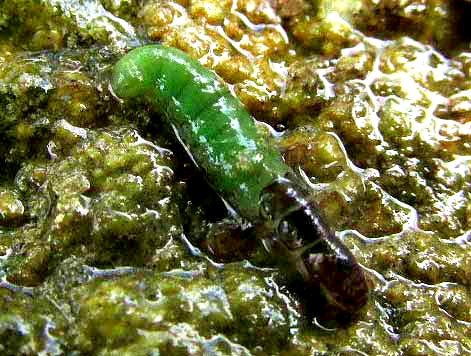Excerpts from Jim Conrad's
Naturalist Newsletter
from the August 10, 2014 Newsletter issued from the Frio Canyon Nature Education Center in the valley of the Dry Frio River in northern Uvalde County, southwestern Texas, on the southern border of the Edwards Plateau; elevation ~1750m (~5750 ft); N29.62°, W99.86°; USA
CADDISFLY LARVA
The other day in the barely trickling waters of the upper Dry Frio River I picked up a submerged limestone rock just to see what aquatic being might be stuck to its bottom. My mind could not reconcile what I thought I saw and what I knew of aquatic animals.
For, it seemed that a juicy, green caterpillar clung to the rock's undersurface, though I'd never seen an aquatic, juicy, green caterpillar. Certain fly-type insects, such as horseflies, metamorphose through an aquatic, wormy stage, but those larvae look more like maggots than caterpillars. Caterpillars are larvae of moths and butterflies, and I have read of aquatic caterpillars, but so far I haven't consciously seen one, much less such a succulent, green one.
Moreover, it seemed that the fat, green caterpillar was being dragged by the head across the wet rock by a black ant, and I certainly have not heard of aquatic ants. I photographed this mystery, and when finally the image was on the laptop screen, at least part of the mystery was solved. You can see the image below:

The "black ant" was the caterpillar-thing's front end. But, I'd never seen a caterpillar designed like that, either, much less an aquatic one.
Some creative Googling finally clarified matters.
Until now my experience with caddisfly larvae had been that in running water they occupy cone-shaped, bagworm-like cases to which tiny twig fragments adhere, providing camouflage and armor. I had been looking for such a case beneath the stones I was picking up that morning. Well, despite my experience with caddisfly larvae in submerged, bagworm-like cases, our "green, aquatic caterpillar" was a caddisfly larva.
Since caddisflies constitute one of the largest groups of aquatic insects, with about 7,100 described species worldwide and some 1,340 species in North America, and their larvae have adapted to a huge range of different microhabitats, it should be no surprise that all caddisfly larvae don't fit my one stereotype.
Since caddisflies are neither moths nor butterflies, their larvae are not caterpillars -- though caddisflies are closely related to butterflies and moths, so their larvae have a right to look like caterpillars. However, caterpillars bear many appendages, called prolegs, along their abdominal segment, but caddisfly larvae have only a single pair located near the tip, or rear end, of the abdomen. They also bear various kinds of bristles and exterior gills, but none of those features show in our image.
With so many species I can't say which one our picture shows. However, a common, widely occurring species found in our area and whose pictures look exactly like ours is MACROSTEMUM CAROLINA, so that's how I'm filing our picture and information here, until an expert informs me otherwise. Sometimes, because the adult's wings are blotchy black-and-white, this species is known as the Zebra Caddisfly. It occurs in the US Southeast, as far west as Texas and up the eastern coast as far north as New York.
Instead of the bagworm-like larva case I was familiar with, the Zebra Caddisfly builds a silken canopy over a small natural depression or gouging in a submerged tree branch or snag, orienting the canopy's water intake and outflow holes so that water currents carry suspended food into the chamber to the hungry caddisfly larva. Most kinds of caddisfly larva are herbivorous scavengers, feeding mainly on fragments of plant material, living vegetation, and other living and dead organisms